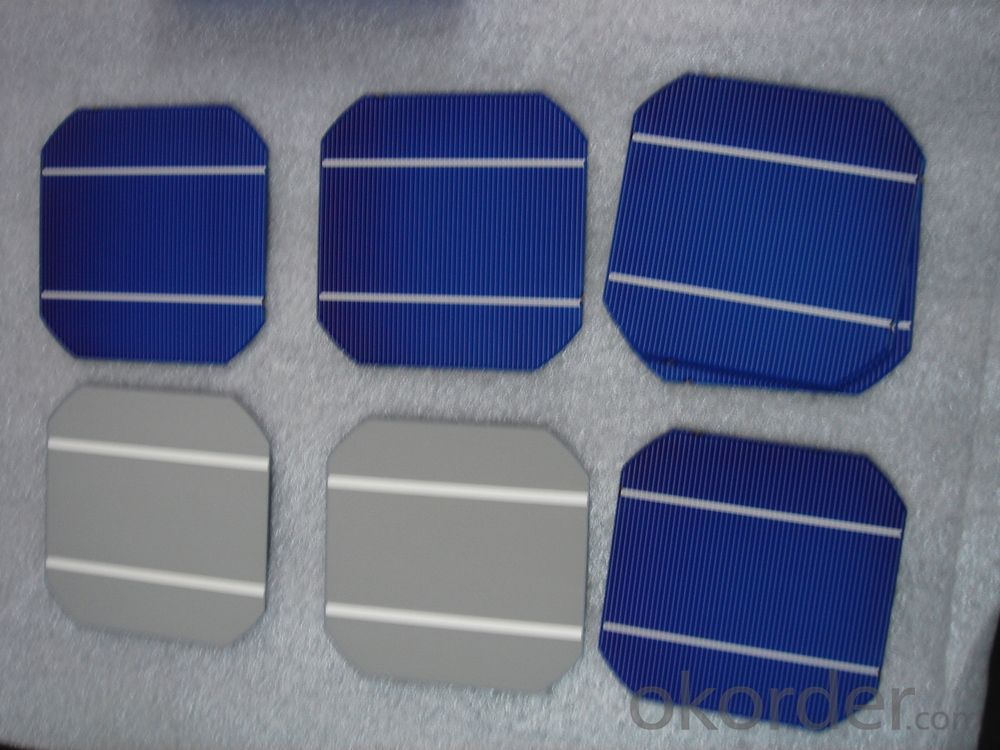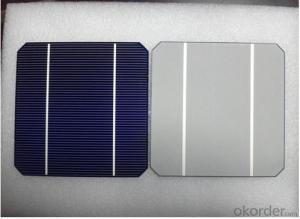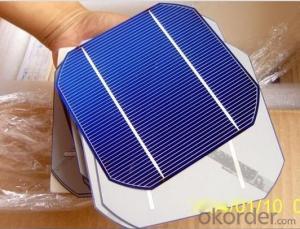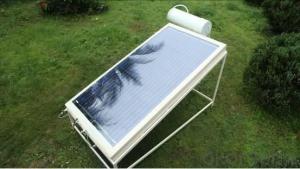125 Mono Solar Cell 5 Inch Efficiency 2.85W-3.5W
- Loading Port:
- Shanghai
- Payment Terms:
- TT or LC
- Min Order Qty:
- 500 pc
- Supply Capability:
- 10000 pc/month
OKorder Service Pledge
OKorder Financial Service
You Might Also Like
| Quick Details | |||||
| Material: | Monocrystalline Silicon | Bus Bar: | 2 | Grade: | A |
| Size: | 125*125mm | Max. Power: | 2.85w-3.5W | Efficiency: | 18.6-22.87 |
| Packaging & Delivery | |
| Packaging Detail: | Typical package for one box is 1,000 cells.These cells are sealed in paper boards every 100 PCS.Gross weight per unit box shall be around 16kg |
5'' High Efficiency Mono Solar Cell 125*125 mm



Our Advantage
Reason:
We enjoy exclusive channel to get solar cells at more competitive price from Sunpower,Neo solar,Motech,Gintechetc.
We signed long term purchase contract with Taiwan tier 1 solar cell manufacturers,including but not limited to Neo solar,Motech,Gintech,AUO,then we can purchase unsorted solar cells in bulk from them and sort these unsorted solar cells into same efficiency,same pattern,same color by our own QA team. We call them Grade A-.
Quality :
These sorted solar cells have same electrical performance with Taiwan Grade A solar cells,only difference is the negligible superficial defect.
We can guarantee that they are better than grade A solar cells from tier 1 solar cell manufacturers in China mainland.
Description
1.Mechanical Specification:
Product Mono-crystalline silicon solar cell
Dimension 125 mm x 125 mm ± 0.5 mm
Thickness 200 μm ± 30 μm
Front 1.4mm bus bar(silver),blue anti-reflecting coating(silicon nitride)
Back 2.0 mm wide soldering pads(silver) Back surface field (aluminum)
2.Electrical Properties
| Efficiency (%) Pmpp (W) Vmpp(V) lmpp (A) Voc(V) lsc(A) |
| 19.40-19.50 3.01 0.54 5.61 0.64 5.93 |
| 19.30-19.40 2.99 0.54 5.58 0.64 5.92 |
| 19.20-19.30 2.97 0.54 5.55 0.64 5.92 |
| 19.10-19.20 2.96 0.53 5.54 0.64 5.90 |
| 19.00-19.10 2.94 0.53 5.51 0.64 5.89 |
| 18.90-19.00 2.93 0.53 5.50 0.63 5.87 |
| 18.80-18.90 2.91 0.53 5.47 0.63 5.86 |
| 18.70-18.80 2.90 0.53 5.46 0.63 5.85 |
| 18.60-18.70 2.88 0.53 5.43 0.63 5.84 |
| 18.40-18.60 2.85 0.53 5.40 0.63 |
Packaging & Shipping
1. Payment term: T/T in advance (W/U for sample order)
2. Lead time: It depends on your quantity. Usually we will send sample within 1-3 working days.
3. Shipping will be made via EMS, DHL, TNT, UPS, Air, Sea etc. shipment
4. Others: If you have special specifications and requirements, we will do different offer as you required.
Our Services
Pre sale:
1.Our sales representative and engineer work together to answer your questions and offer solution for free
2.We choose the best product for you to make sure it worth its real value
3.We design the best solution with good perfomance for you,manwhile save every cent of your money.
After sale:
We can change broken solar cell for you or compensate for your lost.
Solar cells are electronic semiconductor components, by means of which sunlight can be converted into electric energy. The semiconductor body can consist, for instance, of silicon or a III-V compound such as gallium arsenide and is provided on its front side facing the radiation source with a p-n junction of large area by means of diffusion.
A method for manufacturing solar cells comprising growing semiconductor whiskers on a substrate, comprising:
(a) Providing a substrate which favors growth or germination of whiskers;
(b) Depositing a plurality of localized areas of an agent in which the semiconductor material is soluble;
(c) Growing whiskers of said semiconductor material by means of the Vapor Liquid Solid (VLS) method at said areas;
(d) Doping the whiskers with one of a p or n doping material; and
(e) Subsequently thereto doping the surface region of said whiskers up to a depth which approximately corresponds to the diffusion length of the charge carriers pairs with the other of a P or n doping material.
Estimating the manufacturing cost of purely organic solar cells
we estimate the manufacturing cost of purely organic solar cells. We find a very large range since the technology is still very young. We estimate that the manufacturing cost for purely organic solar cells will range between $50 and $140/m2. Under the assumption of 5% efficiency, this leads to a module cost of between $1.00 and $2.83/Wp. Under the assumption of a 5-year lifetime, this leads to a levelized cost of electricity (LEC) of between 49¢ and 85¢/kWh. In order to achieve a more competitive COE of about 7¢/kWh, we would need to increase efficiency to 15% and lifetime to between 15–20 years.
Manufacturing Solar Cells
First, silicon raw material is melted and re-cast to remove impurities. The cast silicon is then stabilized in its multicrystalline form. These castings, called "ingots," are then cut into blocks. Next, the ingots are sliced into wafers.( Depending on the type of silicon used, p-type or n-type silicon wafers may be produced). After layering the p-type or n-type wafers, the material is capable of generating electricity from sunlight. Electrodes are attached to the wafers to conduct the flow of electricity. This is called a photovoltaic cell, or "solar cell."
- Q:Can solar cells be used in farming or agriculture?
- Yes, solar cells can be used in farming or agriculture. They can be used to power various agricultural processes such as irrigation systems, lighting, and machinery. Additionally, solar panels can be installed on rooftops or in fields to generate electricity, reducing reliance on the grid and providing a sustainable energy source for farming operations.
- Q:How does the solar panel produce it yourself?
- Step 4: Add Electrolytes Use iodine-containing solutions as the electrolyte for solar cells, which are mainly used for the reduction and regeneration of fuels. One or two drops of electrolyte can be added to the surface of the titanium dioxide film.
- Q:Is that true that the price of solar cells will be reduced in the coming year?
- According to the research and survery we did recently in the 2nd tier cities in China, the possibility of the solar cells' price going down is very low. Reasons? All the solar cells project hasn't started yet at the end of the last year in the 2nd tier cities in China. The market won't allow the price to go down.
- Q:What is the role of bypass diodes in solar cell systems?
- The role of bypass diodes in solar cell systems is to prevent the damage caused by shading or partial shading of the solar panels. These diodes provide an alternate path for the current to flow when some portions of the solar panels are shaded, ensuring that the rest of the panels can still generate electricity efficiently. By diverting the current around the shaded area, bypass diodes help to maintain the overall performance and reliability of the solar cell system.
- Q:Can solar cells be used in airports?
- Yes, solar cells can be used in airports. In fact, many airports around the world have already started using solar panels to generate clean and renewable energy. These solar cells are typically installed on rooftops, canopies, or open areas near the airport to harness sunlight and convert it into electricity. This helps airports reduce their carbon footprint, lower energy costs, and contribute towards sustainability goals.
- Q:Can solar cells be used in indoor applications?
- Yes, solar cells can be used in indoor applications. While solar cells primarily generate electricity from sunlight, they can also convert artificial light sources, such as fluorescent or LED lighting, into electricity. This makes them suitable for powering various indoor devices and applications, including calculators, wireless sensors, and even indoor lighting systems.
- Q:Can solar cells be used in recreational vehicles (RVs)?
- Yes, solar cells can be used in recreational vehicles (RVs). Solar panels mounted on the roof of an RV can capture sunlight and convert it into electricity, which can then be used to power various appliances and systems within the vehicle, such as lights, fans, refrigerators, and charging devices. This allows RV owners to have a reliable and sustainable source of energy while on the road, reducing their reliance on traditional power sources and increasing their independence during outdoor adventures.
- Q:Where and how can I find more information of Photovoltaic Cells Solar Panels? Can anybody share more about that?
- Photovoltaic Cells, known as PV cells, is very special because it has no moving parts, which means you don't need any visual high technology to keep systems up and running.
- Q:What is the role of solar cells in solar-powered water heaters?
- The role of solar cells in solar-powered water heaters is to capture sunlight and convert it into electricity. This electricity is then used to power the heating element or pump in the water heater, allowing it to heat water using clean and renewable energy from the sun.
- Q:Can solar cells be used to power large industrial facilities?
- Yes, solar cells can be used to power large industrial facilities. However, the feasibility and effectiveness of using solar cells for such facilities depend on factors such as the size of the facility, its energy requirements, available space for installing solar panels, and the cost-effectiveness of implementing and maintaining the solar power system.
1. Manufacturer Overview |
|
|---|---|
| Location | |
| Year Established | |
| Annual Output Value | |
| Main Markets | |
| Company Certifications | |
2. Manufacturer Certificates |
|
|---|---|
| a) Certification Name | |
| Range | |
| Reference | |
| Validity Period | |
3. Manufacturer Capability |
|
|---|---|
| a)Trade Capacity | |
| Nearest Port | |
| Export Percentage | |
| No.of Employees in Trade Department | |
| Language Spoken: | |
| b)Factory Information | |
| Factory Size: | |
| No. of Production Lines | |
| Contract Manufacturing | |
| Product Price Range | |
Send your message to us
125 Mono Solar Cell 5 Inch Efficiency 2.85W-3.5W
- Loading Port:
- Shanghai
- Payment Terms:
- TT or LC
- Min Order Qty:
- 500 pc
- Supply Capability:
- 10000 pc/month
OKorder Service Pledge
OKorder Financial Service
Similar products
New products
Hot products
Hot Searches
Related keywords






























